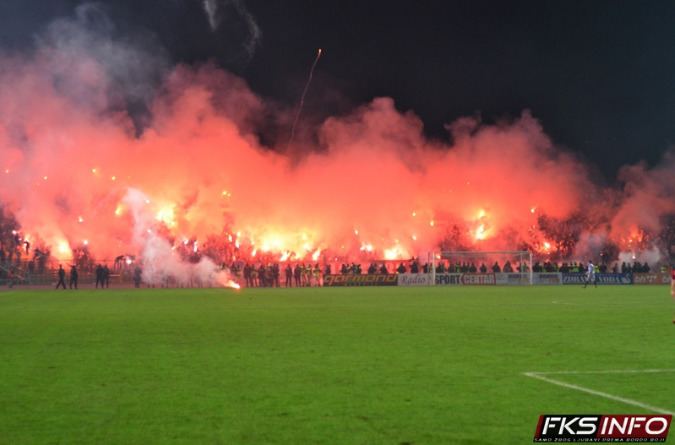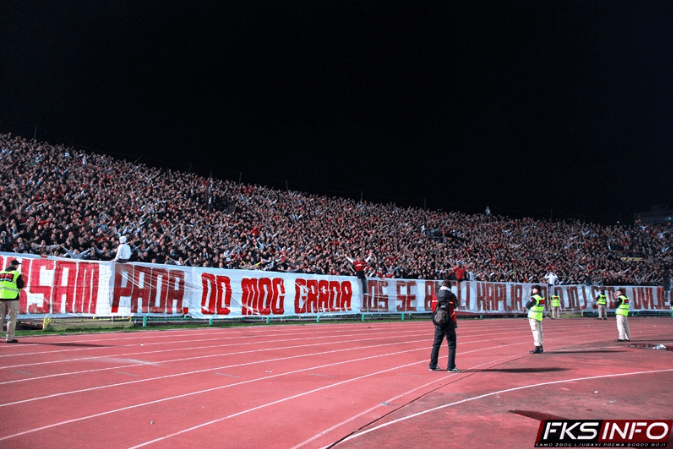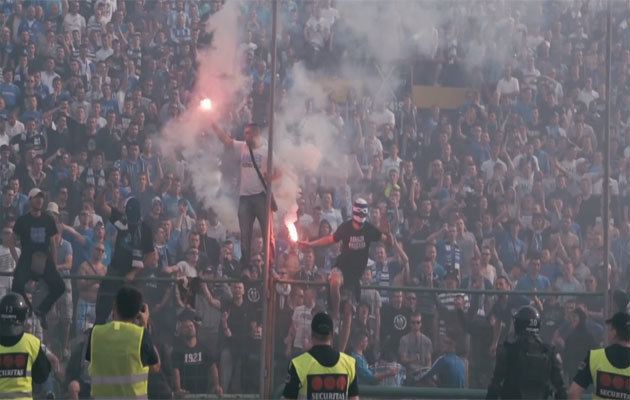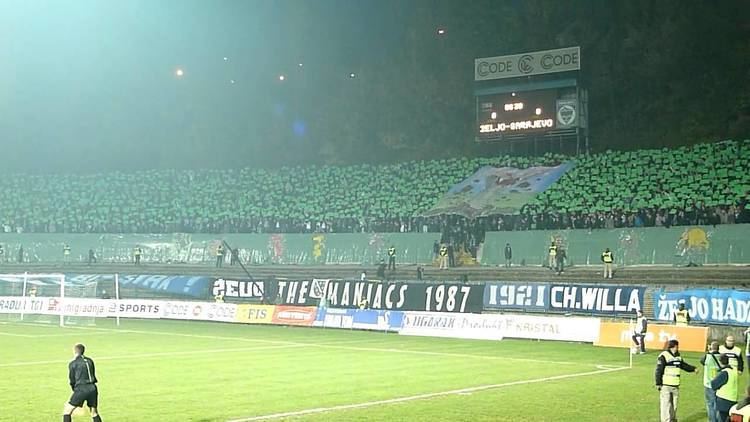Other names Eternal derby Latest meeting 24 April 2016 | First meeting 12 August 1954 Also called Eternal derby | |
 | ||
Meetings total Total: 127Official: 108 (League competition) | ||
Pyro flares chaos spencer fc experiences sarajevo derby real football
The Sarajevo derby (Vječiti derbi; Sarajevski derbi) is a match between rivals from Bosnia's capital city FK Željezničar Sarajevo and FK Sarajevo, the two biggest and most popular clubs in Bosnia, during which fans usually create a competitive atmosphere with a big flags, paper rolls, scarfs and loud chanting. It is not uncommon to see members of the same family on opposite sides, not speaking to each other on the day of the derby, with opposing fans engaging in mutual provocations at the end of the match, eagerly awaiting the next confrontation although, in recent years, this has led to clashes between some younger fans.
Contents
- Pyro flares chaos spencer fc experiences sarajevo derby real football
- Sarajevo derby zeljeznicar vs fk sarajevo manijaci and horde zla 4th october 2015
- History
- Other competitions
- Head to head ranking in Premier League of Bosnia
- Records
- Fans
- Little derby
- References

Sarajevo derby zeljeznicar vs fk sarajevo manijaci and horde zla 4th october 2015
History

The history of the Sarajevo derby dates back to 1954, but the rivalry began eight years earlier. At the end of the Second World War the two major clubs in Sarajevo, SAŠK and Slavija, were disbanded by the new authorities which formed FK Sarajevo in 1946. Since the idea was for this new club to represent the city on a national level, SD Torpedo, as initially FK Sarajevo was called, needed the best players from the city. Numerous notable players were brought to the club, and they received good salaries for that time. On the other side, FK Željezničar Sarajevo is a club which was formed by a group of railway workers much earlier, in 1921. However, until then, during the pre-war period, they were in the shadow of SAŠK and Slavija and had never menaged to qualify to the Yugoslav Championship. Željezničar won the second-tier Bosnian championship title in 1946, as part of the Yugoslav football league system, and that achievement marked the beginning of their climb. After the war, these two clubs became the most prominent and successful in Sarajevo, and since then, the rivalry between the two has been intense.

FK Sarajevo supporters were considered to be upper-class individuals, mainly from Bosniak dominated old and central parts of town. On the other side, supporters of FK Željezničar were usually working-class with liberal image. Those differences were later partly erased. Both clubs have supporters from all classes and from all ethnic groups, even if FK Sarajevo fan base is still very predominately Bosniak. FK Željezničar have the image of liberal club and they are popular even among other supporters in the region, while FK Sarajevo's support outside Sarajevo comes mostly from the Bosniak dominated areas in the region and diaspora.

Since they played in different levels, first matches between FK Željezničar and FK Sarajevo were friendlies. The first official league match was held in 1954; FK Sarajevo won 6-1. That is still the biggest victory by any team in these matches.

As of 2015, 104 league matches have been played. Željezničar won 30 times, Sarajevo won 31 times, while 43 matches ended in a draw. Goal difference is 123-119 in FK Sarajevo's favour. In all competition Željezničar and Sarajevo have played 124 times, Sarajevo have won 39 times, Željezničar have won 38 times and 47 games end in a draw.
Other competitions

The Sarajevo derby is currently played twice a year in the Premier league, but they may also play against one another in other competitions. There are also friendly matches and games played in various tournaments. Although these games are not included in official statistics, they are just as important as the ones played in the league.
as of 26 March 2014
Head-to-head ranking in Premier League of Bosnia
• Total: FK Sarajevo 12 times higher, FK Željezničar Sarajevo 9 times higher.
Records
Note that only league matches are included in statistics. Cup, other tournaments and friendly matches are not included.
Fans
Probably the best known thing about the Sarajevo derby are the fans. Usually, they are much more exciting to watch than the game itself. Especially in recent times, since the Bosnian championship has at times lacked in quality. Fans create an impressive atmosphere with loud cheering and original choreography. Both sides prepare intensely between the matches, make large flags and special messages that are appropriate for that particular occasion, to be usually directed towards the opposing side.
FK Željezničar's most passionate fans (wearing blue) are called Manijaci because their love for the club is on the edge of insanity, so it is said. They are located on the South side of stadium (the Holy South as they call it). The older fans ones are known affectionately as the Košpicari (which can metaphorically be translated as "seed eaters", although the name itself has different meaning - namely that of "seed sellers").
FK Sarajevo's most passionate fans (crimson) are called the Horde Zla (Evil hordes) after the popular Zagor comic book. In home games at Asim Ferhatović Hase Stadium, they are located on the North stands, while the older fans are known as the Pitari (similar to the Košpicari etymology except referring to pie and not seeds) and they are mainly on the East side.
When the derby is played on Grbavica Stadium, Horde zla are on the East and NE side of the stadium, The Maniacs are on the South and West side, while the Pitari and Košpicari are on the North. When the games is played on Koševo, The Maniacs are on the South and SW side, Horde zla on the North and the East. Pitari are on the East as well. West stands are mixed with both Pitari and Košpicari sitting there.
Little derby
Third football club from Sarajevo is Olimpic; located in the small neighbourhood of Otoka. It has been part of Premier League of Bosnia and Herzegovina since 2009–10 season and their support group is very small. Olimpic's games between its rivals of FK Sarajevo and FK Zeljeznicar in town are known as little town derby (Mali gradski derbi).
